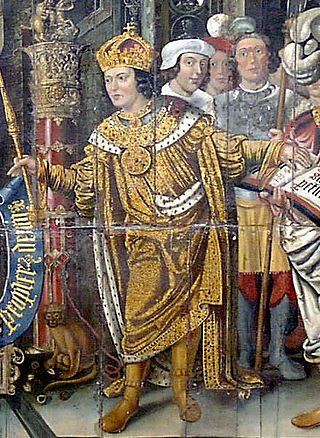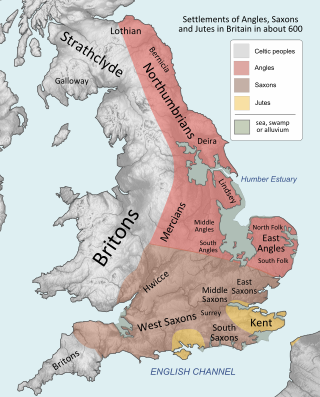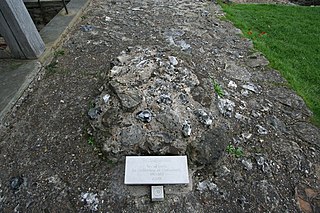
Ceawlin was a King of Wessex. He may have been the son of Cynric of Wessex and the grandson of Cerdic of Wessex, whom the Anglo-Saxon Chronicle represents as the leader of the first group of Saxons to come to the land which later became Wessex. Ceawlin was active during the last years of the Anglo-Saxon expansion, with little of southern England remaining in the control of the native Britons by the time of his death.

The Kingdom of the West Saxons, also known as the Kingdom of Wessex, was an Anglo-Saxon kingdom in the south of Great Britain, from around 519 until England was unified in 927.
Oswiu, also known as Oswy or Oswig, was King of Bernicia from 642 and of Northumbria from 654 until his death. He is notable for his role at the Synod of Whitby in 664, which ultimately brought the church in Northumbria into conformity with the wider Catholic Church.

Wulfhere or Wulfar was King of Mercia from 658 until 675 AD. He was the first Christian king of all of Mercia, though it is not known when or how he converted from Anglo-Saxon paganism. His accession marked the end of Oswiu of Northumbria's overlordship of southern England, and Wulfhere extended his influence over much of that region. His campaigns against the West Saxons led to Mercian control of much of the Thames valley. He conquered the Isle of Wight and the Meon valley and gave them to King Æthelwealh of the South Saxons. He also had influence in Surrey, Essex, and Kent. He married Eormenhild, the daughter of King Eorcenberht of Kent.

Cædwalla was the King of Wessex from approximately 685 until he abdicated in 688. His name is derived from the Welsh Cadwallon. He was exiled from Wessex as a youth and during this period gathered forces and attacked the South Saxons, killing their king, Æthelwealh, in what is now Sussex. Cædwalla was unable to hold the South Saxon territory, however, and was driven out by Æthelwealh's ealdormen. In either 685 or 686, he became King of Wessex. He may have been involved in suppressing rival dynasties at this time, as an early source records that Wessex was ruled by underkings until Cædwalla.
Æthelhere was King of East Anglia from 653 or 654 until his death. He was a member of the ruling Wuffingas dynasty and one of three sons of Eni to rule East Anglia as Christian kings. He was a nephew of Rædwald, who was the first of the Wuffingas of which more than a name is known.

Anna was king of East Anglia from the early 640s until his death. He was a member of the Wuffingas family, the ruling dynasty of the East Angles, and one of the three sons of Eni who ruled the kingdom of East Anglia, succeeding some time after Ecgric was killed in battle by Penda of Mercia. Anna was praised by Bede for his devotion to Christianity and was renowned for the saintliness of his family: his son Jurmin and all his daughters – Seaxburh, Æthelthryth, Æthelburh and possibly a fourth, Wihtburh – were canonised.
Cenwalh, also Cenwealh or Coenwalh, was King of Wessex from c. 642 to c. 645 and from c. 648 until his death, according to the Anglo-Saxon Chronicle, in c. 672.
Centwine was King of Wessex from c. 676 to 685 or 686, although he was perhaps not the only king of the West Saxons at the time.
Æscwine was a King of Wessex from about 674 to 676, but was probably not the only king in Wessex at the time.
Seaxburh was a queen of Wessex. She is also called Queen of the Gewisse, an early name for the tribe which ruled Wessex. She is said to have ruled Wessex for between one and two years after the death of her husband, Cenwalh, in 672. Her accession to the throne is documented in the Anglo-Saxon Chronicle for that year which states that "This year king Kenwalk died, and Sexburga his queen reigned one year after him". It was extremely rare for a woman to rule in suo jure in Anglo-Saxon England, and she was the only woman to appear in a regnal list. She may have ruled for over a year, as the next reign is entered in the Anglo-Saxon Chronicle in 674.
Ceolwulf was a king of Wessex. At that early date the West Saxons were called the Gewisse, and in his Dictionary of National Biography entry he is given the title "king of the Gewisse". According to the Anglo-Saxon Chronicle, he reigned fourteen years and the Annals of St Neots also allot him fourteen years. The West Saxon Genealogical Regnal List gives him a reign of seventeen years.
Ceol is portrayed by the Anglo-Saxon Chronicle and West Saxon Genealogical Regnal List as King of Wessex for five to six years around 592 to 597 or 588 to 594.

Cwichelm was an Anglo-Saxon king of the Gewisse, a people in the upper Thames area who later created the kingdom of Wessex. He is usually counted among the Kings of Wessex.
Coenred was king of Northumbria from 716 to 718.
The Timeline of conflict in Anglo-Saxon Britain is concerned with the period of history from just before the departure of the Roman Army, in the 4th century, to just after the Norman Conquest in the 11th century.
Cuthwine, born c. 565, was a member of the House of Wessex, the son of King Ceawlin of Wessex. Cuthwine's father Ceawlin was deposed from the throne of Wessex in 592 by his nephew Ceol. Therefore, Cuthwine never inherited the throne. Cuthwine went into exile for many decades, remaining a strong leader of the Saxons and passing on the royal line through his three sons.
Cuthwulf, also sometimes Cutha, was the third son of Cuthwine, and consequently a member of the House of Wessex. Although a member of the direct male line from Cynric to Egbert, Cuthwulf was never king. He is said to have been born circa 592, and his death date is unknown.

Events from the 7th century in England.
The Christianisation of Anglo-Saxon England was a process spanning the 7th century. It was essentially the result of the Gregorian mission of 597, which was joined by the efforts of the Hiberno-Scottish mission from the 630s. From the 8th century, the Anglo-Saxon mission was, in turn, instrumental in the conversion of the population of the Frankish Empire.









